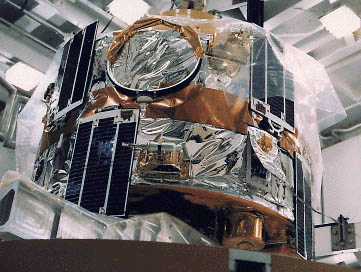|
|
Solrad 11A/B

The two spacecraft were launched together on 15 March 1976, and positioned
~180 degrees apart at an altitude of ~20 Earth radii. The two satellites
each carried an identical complement of 25 experiments to
measure solar electromagnetic and charged particle emissions, Earth auroral
and stellar X-ray emission, terrestrial and interplanetary extreme ultraviolet
emission, X-ray and charged particle emission from the anti-solar
direction, and gamma-ray bursts. The modest gamma-ray burst monitors were
added to the almost completed Solrad 11A and 11B satellites. This last minute
addition was accomplished through cooperation between Los Alamos National
Laboratory and the Naval Research Laboratory after the Vela results became
known. 11B ceased telemetry transmission in December 1976. 11A continued to
operate sporadically until July 1977.
The gamma-ray burst instrument on each satellite was roughly
omnidirectional and sensitive to the energy range 0.2-2 MeV. Each consisted
of a pair of 1.5 inch x 1.5 inch CsI scintillation detectors. A total
average count rate during any 0.625 s interval greater than 7-sigma above
background triggered the system. Data for the burst, including 0.6 s of pre
-trigger data, could have the temporal information recorded in either of 2
ways: for count rates below 1092 cps, the total number of counts accumulated
in 14.65 ms was recorded. For count rates greater than 1092 c/s, the time
interval required to record 16 counts was recorded with 0.3 ms resolution.
There were 4 spectral channels: 0.2-0.3, 0.3-0.4, 0.4-0.6, and 0.6-2.0 MeV.
The spectral channels were read every 8 time accumulations. Thus the
spectral accumulation time ranged from 2.4 to 117.2 ms. No in-flight
calibration was available. So the spectral data could be used to search for
variability, but not to obtain spectral shapes.
The 2 gamma-ray burst instruments recorded a total of 9 gamma-ray bursts.
Eight of these were seen by at least 1 Vela satellite, thus verifying the
events. Four of the events were also seen by Helios-2.
[Gallery]
[Publications]
[All Missions]
[by Time]
[by Energy]
Page authors: Lorella Angelini Jesse Allen
HEASARC Home |
Observatories |
Archive |
Calibration |
Software |
Tools |
Students/Teachers/Public
Last modified: Thursday, 26-Jun-2003 13:48:17 EDT
|


